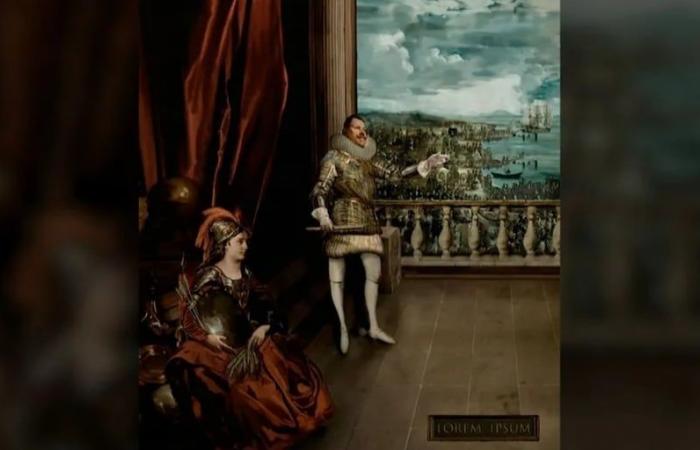It was difficult to access the Gallery of the Royal Collections this morning, since the rehearsal for the parade of the three Armies and the Civil Guard was taking place in the Plaza de la Armería, which will take place tomorrow as part of the celebrations of the tenth … anniversary of the proclamation of Felipe VI as King.
The presence of contemporary art in the Gallery it is limited to two pieces at the end of the tour. On the one hand, the tapestry ‘Allegory of Peace’, by Guillermo Pérez Villalta; on the other, a copy of the prince edition of the Spanish Constitution of 1978 with a serigraph by the artist José Luis Alexanco, who died in 2021, who was in charge of the model and artistic direction, the design of the typefaces and the watermark. But to commemorate its first anniversary, the Gallery has prepared a program of activities that includes performing arts, music, film and contemporary art.
The latter is incorporated with a proposal under the title ‘Alterations’which proposes, until September 22, a subtle re-reading, without disturbing the museography, of the collections and spaces of the Gallery through three interventions by many other contemporary artists, which can be visited free of charge with general admission. The purpose, approach new audiences. Some interventions that, according to Antonio Sánchez, deputy general director of the Gallery, “contribute to expanding the modes of presentation, generate new stories and enrich the plurality of views on our collections.”
Asunción Molinos, presenting ‘Frottage’
National Heritage
The first proposal is ‘Frottage’, by Asunción Molinoswhich is shown in the anteroom of the Arab wall, on floor A. The artist, whose work straddles anthropology and sociology, has made a series of graphite drawings about the city’s Arab roots: the remains archaeological Arab wall of Madrid. A poetic project in which he has used the ‘frottage’ technique, which consists of rubbing a pencil on a leaf placed on an object, obtaining an impression of it.
Molinos has had the collaboration of a group of Spanish artists of Maghreb origin to ‘rub’ the Arab wall. The artist explains that it was like rubbing Aladdin’s lamp, since the founding elements of the city emerged, the only European capital of Islamic origin, founded in the 9th century. The drawings revealed shapes that resemble water currents, streams, rivers, sparks, fire… “The past, says Molinos, always returns.”
Fernando Sánchez Castillo, during the presentation of the video in which he ‘recovers’ a lost work by Velázquez
National Heritage
Without leaving floor A, the next stop, in the Austrias section, is a video in which Fernando Sánchez Castillo ‘recover’ a lost painting by Velázquez, ‘The kick of the Moorish’destroyed in the fire of the Alcázar of Madrid in 1734. The artist, who makes it clear that he has not made a Velázquez, resorted to artificial intelligence for this «ghost painting, which appears and disappears before our eyes. ‘The Expulsion of the Moriscos’, which reflects an image of power and the role of the Habsburgs as defenders of the Catholic faith, is important in Velazquez’s production, as it was his first foray into history painting, after his portrait production. Only some details of the painting are known through a description of Antonio Palomino ten years before the fire, and from a sketch of the canvas: the face of Philip IIIdiscovered by William B. Jordan, which was donated to the Prado.
‘Philip II offering the Infante Don Fernando to heaven’, by Titian, hung next to the missing ‘Expulsion of the Moriscos’ by Velázquez in the Alcázar Hall of Mirrors. A recently arrived Velázquez at the Court, who did not meet Philip III, won the competition to make this history painting starring the monarch. He faced Carducho, Cajés and Nardi. The kings of the time had the custom of choosing a painting that symbolized their reign.
Two works by José Luis Alexanco (left), along with the prince’s edition of the Spanish Constitution of 1978 and a tapestry by Guillermo Pérez Villalta
National Heritage
Finally, we go down to the floor dedicated to the Bourbons, where two works of art have been installed. José Luis Alexanco: ‘Aabcdd’ and ‘Substitution of signs’which hang next to the display case that houses the prince edition of the Spanish Constitution of 1978 what the artist did. For her, he created an ‘Alexanco alphabet’, inspired by the watermark of the paper selected for printing. On behalf of Alexanco, his widow, Nieves González, was present at the presentation to the press.
Three works that speak of harmony and coexistence, of cultural and social diversity.






